ARTS & OPINION
Art Culture Analysis
Vol. 9, No. 4, 2010
into eterntiyTHE PASSING OF PURVIS YOUNG

by
DINDY YOKEL
___________________
When I think about Purvis Young, a movie-trailer of moments runs through my mind -- from our first meeting until his death on April 20, 2010. Each snippet a story and education unto itself; run together these clips span three years in Miami.
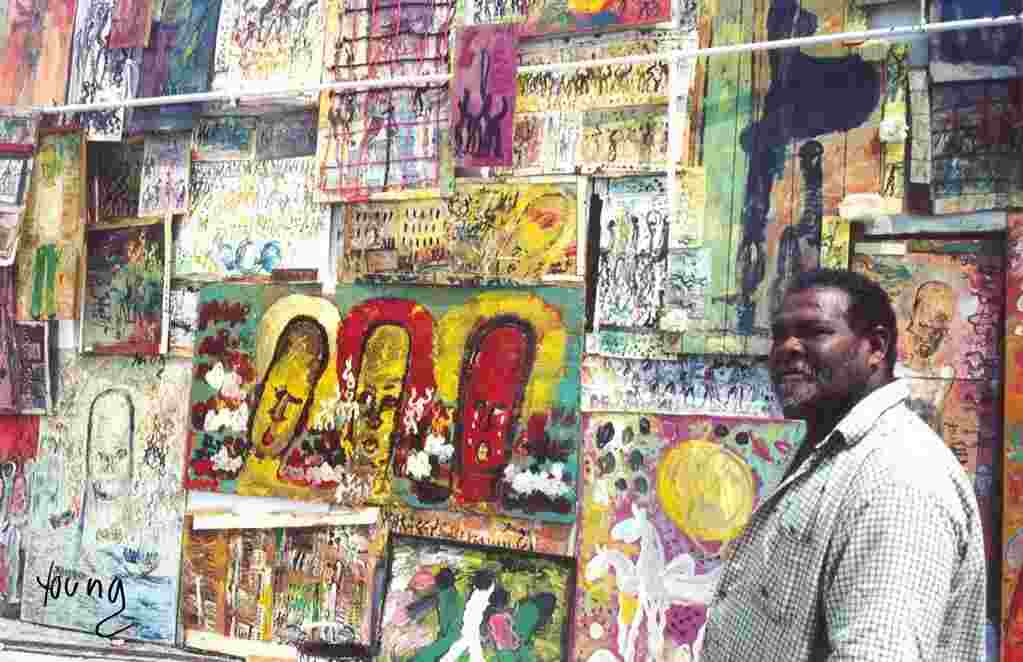
The S & S Diner on NE Second Avenue located across the street from the cemetery is a favourite Miami breakfast spot. Despite twelve years of counter dining where I zipped in and out of this rundown and so-called dangerous part of town, I somehow I missed the secret art studio of Purvis Young across the alley. How many times were we at the diner simultaneously, me eating eggs or pancakes and Purvis his daily tuna fish sandwich? How privileged I was to eat with him at the diner many times after we met.
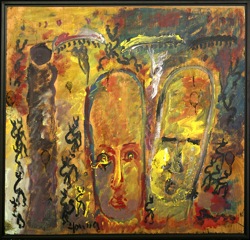
We first met in 2006 when Young was selected as Director’s Choice for the 17th annual Art Miami Contemporary Art fair. Walking into the studio was like walking into one of his paintings. Wildly colourful, everything is recycled or “found” including the red velvet fainting couch that was Young’s favourite perch. My eyes adjusted and I found the artist sitting quietly, petting his rescue dog Goodbread, named after his renowned Goodbread Alley art installation. Weighing in at close to 300 lbs at the time, Young’s girth did not overwhelm the petite couch nor overtake the studio. His serenity counteracted his size.
No matter the time of day a television droned on in a back room
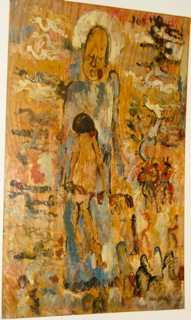
where Young napped; he rarely slept a full night. One evening after an interview with theMiami Herald, I was departing and bent down to give Purvis a hug and kiss on the cheek. He was surprised. “I am 60 years old and you are the first white woman that has touched me.” This shocked me as a true New Yorker, race did not preclude people from touching each other, and hadn’t since the 50s and here it is the first decade of the 21st century in southern Florida and race was still an issue.
There are at least two schools of artists: those who have said all they have to say through their work and those who love to wax erudite about their work. Talking with Purvis about his paintings satisfied my need to understand without hearing a ton of artist-speak. When I inquired about his work he had sharp, short and sane answers.
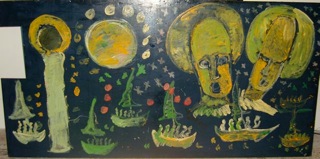
The figure of a nude pregnant woman with her arms stretched to the sky is one of Young’s significant icons appearing alone or in groups throughout he work. “My pregnant woman stands for hope which comes from birth and God,” said Young. Hope, as Young continued, “is a common wish without attention to our colour or religion.” Simple, eloquent and something that we can all relate to and desire. The viewer doesn’t have to “get” Young’s work or be given an interpretation by art world experts. The work appeals on a visceral level, the story is obvious, the colours glorious and the materials are those we encounter everywhere and not only in art supply stores.
Scores of people, either white or black, populate his paintings. The black groups represent Purvis’ “tribe” and those upon horseback are the leaders. Horses represent freedom. Succinct and easy to grasp, we all have our groups whether by race, religion or location. We yearn for community and belonging and Purvis understood this well. He often spoke about “finding” and rejoining his African tribe after death.
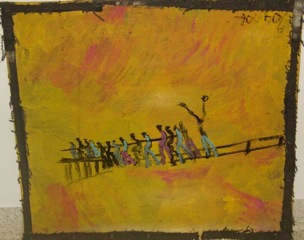
Many considered Young simple of mind and unstable as examples of his belonging to the genre of outsider artist. Having known Purvis, he was neither. He was very private and shared his thoughts with those in his very tight circle of family and a smattering of friends, many of whom have been in his life for decades.
Young also received these labels due to his unfortunate dealings with people who stole from him, misrepresented him and used him for their own good. What this came from was his willingness to trust people, regardless of warnings from others and foul treatment experienced first hand. He kept people in his world long after they proved themselves untrustworthy -- Purvis gave people unlimited opportunities to redeem themselves with him. Somebody must be crazy to allow others to take and take without putting an end to the problem, don’t they?
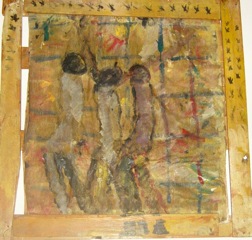
Purvis wasn’t crazy -- he was a people-pleaser. People wanted his art and so he painted prolifically. People wanted to lay claim to him and he acquiesced not because he didn’t know better but because he wanted to give everyone in his life whatever they wanted. He was generous and loving. He treated Eddie Mae’s children and grandchildren as if they were his own. Nothing illustrated his sanity better than observing Purvis talk with his grandchildren -- but this was private. As was his sadness when his dog “disappeared” after a stint in the hospital. He was convinced that those meant to care for Goodbread simply let him go in the streets. Until the last days of his life Purvis missed this sweet dog.
His trusting nature yielded financial problems and mishandling of his career by others. A simple Google search will bring these names to light but have no business here as they have benefited enough from Purvis. During the final years of his life misery was his frame of mind as his ability to run his own life was legally stripped from him.
All Purvis wanted was freedom and this was something he never had. He wanted to live life his way and paint what he wanted when he wanted and these options were taken from him. Others had their opinion of him shaped by the courts, doctors and the public. He preferred not to fight or rebel other than through the messages in his art. “I realized that standing up for what I believe and fighting for it would only land me in jail. I went once and that was enough. From then on, I expressed my thoughts through my paintings instead of through my fists.”
His legacy is already being mishandled and his work sold at bargain prices when it should be increasing in value because there is no more and yet there is so much. He was a treasure and but never regarded as such. Purvis was a kind and loving man, a family man who deserved a better life. He will be missed and those of us who were privy to his intuitive and insightful thinking will wish more had been written down so that others could know the man and not the portrait painted by others.
Goodbye my friend, I hope you have found your tribe in heaven and are resting easy.
Images are courtesy of Doug Hirsch.



